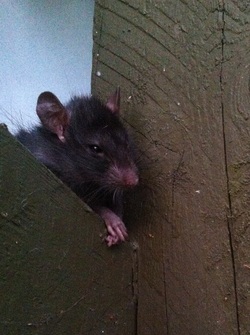 Usually, our annual war on Roof Rats (Rattus rattus) begins in November when the first heavy rains of winter tend to drive Roof Rats into the garage and the house. . The past two years however, our battle with the wiley and prodigious rodent has started at the end of August as the Roof Rats have turned to our tomato patch and started to eat our tomatoes on the vine just before they ripen. We think we finally have found the last remaining hole that they can gain entry into the house. This small opening along side the chimney required a gymnastic maneuver worthy of a Cirque du Soliel artist. Steel wool has proven to be the most evective deterrent to the chewing rodents. Roof Rats have proven to be an expensive species, most notably by eating the insulation off the wiring system of one of our vehicles. They were also the reason we eventually moved to an all metal garbage can for storing bird seed and entirely metal compost barrel.
2 Comments
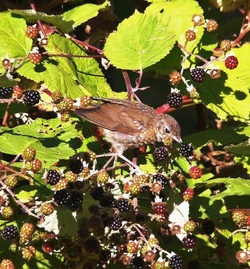 Swainson's Thrush (Catharus ustulatus )is a relatively drab thrush that is found here at Leaning Oaks as a summer time breeder. What it lacks in colour it more than makes up for in its singing abililities. The ascending spiralling notes of this species song is one of my favourite noises of spring and early summer. An added bonus is that it is one of the first songs in the morning and last of the day. The strains of Swainson's Thrushes singing often accompany my "cookie walks" with the dog as we do our last stroll of the day before bed. Our records here span from the second week of May until the 3rd week of September. Click here for a Youtube video of a Swainson's Thrush singing. This photo is a young bird feasting on Himalayan Blackberries, momentarily forgetting that his kind are skulkers that rarely spend much time out in the open. 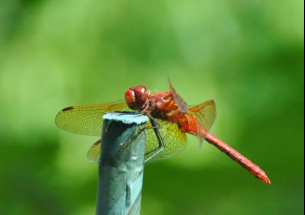 I'd like to know if Sympetrum madidum is breeding in the pond or not-I suspect not as I have only seen a few individuals around the property. This one may have come from other nearby ponds or lakes and was just hanging around feeding. The veins along the top margin of the wings can be a brilliant red, giving it the English name. The red face also makes it stand out. This is the largest of the meadowhawks that are found in B.C.. They breed in still waters in the southern half of B.C. 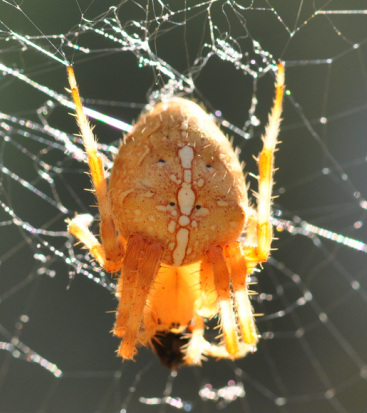 A local spider expert commented that all we had featured were "boring spiders" ....I hope that this species doesn't fall into that category! I think that it is beautiful. This is Araneus diadematus, one of the spiders that builds the classic circular web that is strung between whatever they can find; in this case two Douglas-fir trees. It is an introduction from western and northern Europe and is found through southern Canada and the northern USA. An alternate English name is European Garden Spider--referring both to it's origins and a common habitat. Eggs are laid in sacs in the fall and will hatch in the spring, the adults dying in the fall. Thanks very much to Sean McCann who caught the identification error the first time around. And of course as I look now it is much clearer. Much appreciated. The gurgles, caws, croaks, churrs and a multitude of other sounds that the trickster Raven emits oft fill the air around Leaning Oaks. They are our most common corvid and usually seen here in pairs. They are the reason that the suet feeders are tied tightly with twist ties; this was after seeing one fly past the window with the entire suet block in its large beak. I enjoy watching the rolling and tumbling and acrobatic maneuvers that ravens make while flying, including flying for stints upside down. That really is confusing.
The stories of their intelligence are many. Corvus corax have one of the largest brains in the bird world and a relatively high number of brain cells. Researchers have set up ever increasingly difficult tasks and experiments to test what processes are happening and how they may learn and solve problems. This short National Geographic video, Genius Bird, shows one set of experiments and GrrlScientist takes us through a number of experiments that go beyond the plethora of observations that point to a very clever bird! The role that the raven plays in coastal first nations culture is prominent and complex. Clever and resourceful, yet a mischievous trickster and shape changer. Raven has been credited with the creation of the world, men, women, fire and is featured in stories, sculpture, masks and dance. Dave's wedding ring is a carved raven that Leah commissioned Tony Hunt to create and if she'd had her way the property's name would have raven in there somehow. The only trouble with that was that most of the raven-ish names sounded a bit hippy dippy! Great Blue Heron (Ardea herodias fannini ) is most often a "fly-over" species for us. From time to time, we have a bird stop on the property to check out the pond; or, like last night, stop and roost in one of the trees on the property. Most often these visitors are immature birds. Occasionally a heron will stop and forage for bullfrogs in the pond. Since we seem to be at an all-time high for Bullfrogs, we are hoping that this bird might cue in on this food source and stay around for a while.
The subspecies (A.h. fannini) that occurs here is a darker bird than those in the interior, and is considered to be at risk, by both the Committee on the Status of Endangered Wildlife in Canada (COSEWIC) and by the BC Conservation Data Centre. 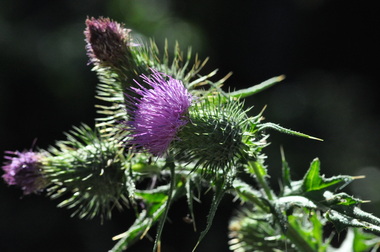 Bull Thistle (Cirsium vulgare), sometimes called Sword Thistle, is a large biennial plant with a deep taproot and formidable spines. They were introduced to eastern North America in the 1800's and is native to Europe, North Africa and Western Asia. Here at Leaning Oaks it only grows in disturbed areas, such as the lawn, the edge of the vegetable garden or where a wind-thrown tree brings up mineral soil and lets the light in. We do try and get rid of them as soon as they come up--however this one had to stay until it flowered becasue we needed a photograph for "Species-A-Day"! In some jurisdictions they are on the noxious weed list for good reason. The large purple flowers are favourites of a variety of introduced and native bees and butterflies and the seed heads attract American Goldfinches and Pine Siskins. The stems are reportedly edible when peeled, but I admit I've never braved the armature to try them out. 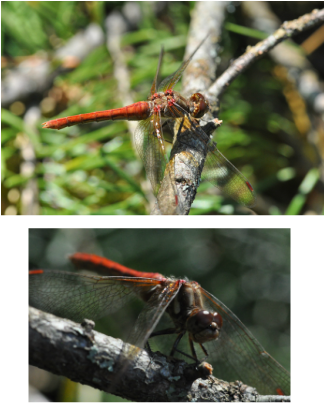 The meadowhawks perch on branches watching all that goes on and darting out to catch unsuspecting prey. The striped meadowhawk or Sympetrum pallipes is common across the southern third of B.C.. It flies through August and September, filling out the later wave of dragonflies in the year. We get at least two species of meadowhawks at Leaning Oaks and this is the paler and duller coloured of the two. There are two thoracic stripes that distinguish this species. It also does have "pale feet", or pallipes! The sound of the Crackling Locust was a common summertime noise when I grew up on Salt Spring Island. Dusty gravel road habitats was where you usually saw this large gray grasshopper. Trimerotropis verruculata are most often seen as they rise into the air, making their characteristic noise and then drop to land on the ground and essentially disappearing, almost perfectly camoflaged on a rock, or in the gravel and dirt on the road. The Crackling Locust uses a variety forest openings . James Miskelly, a biologist who has spent a lot of time looking at B.C.'s grasshoppers, crickets and katydids tells me that we have three species of Trimerotropis here on southern Vancouver Island. T. pallidipennis lives on coastal sand ecosystems. T. fontana is a common species here on rocky outcrops. It has very blue hind tibiae, "as opposed to the sort of blue hind tibiae on T. verruculata". My impression is that this group of grasshoppers has declined since my childhood, but I will admit to spending a lot less time wandering gravel roads than I used to. Thanks to James Miskelly for looking at the photos and identifying this specimen.
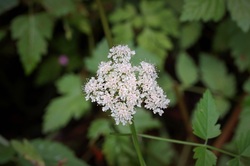 As you might guess from the name, Pacific Water-parsley grows in wet areas. Here it grows in the lowest portion of the property, along the road and the trail that borders two sides of Leaning Oaks. The latin name is Oenanthe sarmentosa. This is one of the genus names that is used for both a plant and an animal, in this case Oenanthe is used for a bird as well, the Wheatear. Oenanthe has the same root word as is used for Oenophile, meaning relating to wine, and a species of Oenanthe was used to flavour wines. (The bird name also references wine, since the arrival of Wheatears in Greece happens at the same time grapes are flowering). There is documentation of this species being both edible and medicinal, however, there are also references suggesting it is poisonous and warning agains its consumption. Given this, plus the fact it would be relatively easy to mistake several other deadly poisonous plants for this species it seems ill advised to try eating or self medicating with this plant. Another species of Oenanthe was the raw ingredient of a poison used to euthanize the elderly in ancient Sardonia. The effects of the poison resulted in a smiling grimace on the face of the victim - which is the origin of the phrase "Sardonic grin". 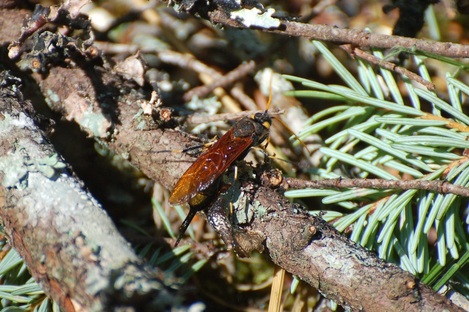 Yesterday we were working at filling our woodshed and packing rounds of Douglas-fir down to the woodshed for splitting. The tree we were working on was felled last week and while we loaded the wheelbarrow we noticed this large wasp buzzing around the log and branches. It would land on or under the tree and walk with jerky motions. The insect involved is the Yellow-horned Horntail. The yellow "horns" of the first part of the common name are actually the antennae and the horntail from the second part of the name, is a growth at the back end of the insect. This appendage is not, as we first assumed, the ovipositor. That organ is under the wasp. I have been unable to find any description of what the horn at the back end is used for...it may simply be designed to be impressive and ward off those that might attack this wasp. This species of horntail (Urocerus flavicornis) lays eggs in dead or dying trees. This they accomplish by inserting thier ovipositor into the tree some 20 mm. They lay a small number of eggs, pump in a solution containing a wood decaying fungus and then move on to the next oviposition site. The larvae hatch out of the eggs in 3-4 weeks, burrowing into the rotting wood and feeding on the fungi digested wood for a number of years. Just before the larvae pupates, it burrows back to near the surface of the wood. After pupation, the adult wasp uses its jaws to chew a hole our of the tree to exit. If the log has been milled into lumber the larvae are capable of surviving in a structure build from the wood and will emerge even if they have to chew through wallboard or hardwood flooring. There is even a record of the European equivalent chewing through lead sheathing covering a timber! Wilson's Warbler (Cardellina pusilla) is a migrant breeding bird here at Leaning Oaks. It arrives in early April and our latest records run into the first week of October. In spring we hear them before we see them, they have a distinctive song a series of descending loud notes unlike any other warbler we have. This is a warbler of thickets and understorey shrubs. Their nests are usually at the base of shrubs, nestled in mosses. These photos were taken yesterday, we had a small fallout of warblers in the yard with Wilson's and two subspecies of Orange-crowned Warblers gleaning insects in the Ocean Spray and Garry Oaks.
This is one of the commonest darners that you will encounter in B.C. (there are 13 in total in case anyone asks*). Aeshna palmata flies from May until late October and there are even records from November. They frequent a range of habitats, particularly lakes and ponds. The male appendages shown in the middle photograph are the source of the English and scientific name for this species. Look also for the dark stripe on the face and the relatively straight thoracic stripes - these distinguish this guy from the other two "paddle-tails".
I have collected several Aeshna exuvia, one of which may be this species. Once I am certain I will add that photograph to this account. It is very exciting to find the abandoned exuvia at the edge of the pond as this shows that the pond is actually being used by these critters to breed and it isn't just a feeding stop-over for the short-lived adults. It's and indicator that we have created a wee functional ecosystem that is healthy enough for odonates. And that the bullfrogs haven't eaten them all! I was bound and determined to not post any dragonflies unless I got some good in flight photos..ha! Bloody difficult. Even when I knew exactly where this fellow was going to be released, it is a bit of a blur! *have I ever mentioned how I caught eight species in one afternoon at one location by myself? Not at Leaning Oaks unfortunately! Black-headed Grosbeak (Pheucticus melanocephalus ) is a relatively new arrival here at Leaning Oaks. Our first record was in August 2007 with a single bird coming to one of our feeders for a few weeks. The next spring we had a number of birds using both the fat and seed feeders and Black-headed Grosbeaks have become a regular bird ever since. Grosbeaks arrive here in early May and staying through August. During May and June they are noisy singers, with male songs described as "an American Robin on amphetamines". Their call notes are also distinctive and many of our August records are based on the call notes, since they sing far less frequently during that months.
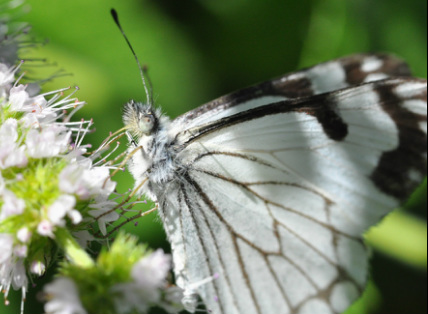 The Pine White will use a variety of conifers as food plants, including Douglas-fir, of which there are many on Leaning Oaks. The females mainly hang out higher in the branches while the males, such as this one, spend time nectaring on flowers. They can have population explosions with severe defoliation of the trees as a result. The last recorded one in B.C. was 1961 where there were "snowdrifts" of Pine Whites along the highway through Cathedral Grove on Vancouver Island. There is another anecdote in Guppy and Shepard's Butterflies of BC that describes another outbreak in 1902 (Fletcher) that describes there being vast numbers of butterflies floating around Vancouver Island and thrown up in windrows along the beaches up to an inch or two in depth. I'd like to see photos! Guppy and Shepard surmise that the lack of current outbreaks may be due to the decline old-growth forest on southern Vancouver Island. Neophasia menapia peak in August. The unsung pollinators; it seems that bees get all the airplay, but as you can see by the pollen grains that flies are also effective pollinators. The Common Green Bottle Fly ( Lucilia sericata) is found in most areas of the world and is common locally. The colour ranges from a coppery colour to metallic green.
How could this beautiful shiny insect be the source of maggots? Just the sound of that word causes revulsion in many, yet they are used in the treatment of wounds. The maggots are placed on the wound where they feed on the necrotic tissues and bacteria in the infected wound. They also produce antimicrobial enzymes that will aid in cleaning up the infected wound. Starting with a clean source of maggots is apparently important! The life cycle and speed of development of the Green Bottle Fly has been intensely studied because of their use in forensics. This fly is usually the first to reach a body and start laying eggs. The stage that the larvae are at when the body is found can reveal a lot about the time of death. It is especially useful if there are details on the temperatures that the corpse was exposed to. Forensic entomology has been used as evidence in many murder trials and makes for fascinating research. 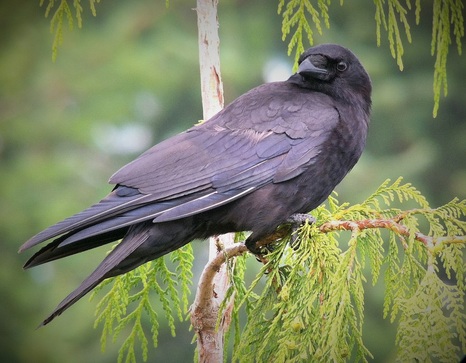 We have three members of the crow family that visit Leaning Oaks regularly. The commonest is the Common Raven, this species (Corvus caurinus ) is the second commonest species. It occurs here year round, although to our knowledge we have never had a pair nest on the property, and the majority of our records are of "fly overs" or calling birds from somewhere else in the neighbourhood. A few times a year we will see birds on the roof of the house or elsewhere on the property. One of the times they are most noticable is when they are mobbing a predator, such as a Cooper's Hawk, Red-tailed Hawk or one of the larger owls. 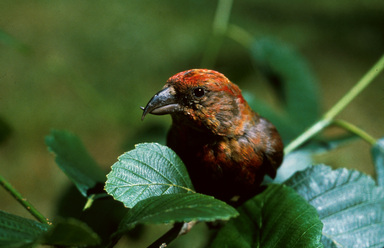 This morning while we were having coffee, two small flocks of Red Crossbills (Loxia curvirostra) flew overhead. Ordinarily this wouldn't be unusual, but Red Crossbills have been almost absent since late last fall with very sparse records on southern Vancouver Island for the last 8 months or so. Red Crossbills are notoriously erratic in movement patterns and abundance, and it would seem they are starting to make a reappearance. To make life more complicated, it is likely that we have a number of different types of Red Crossbills at Leaning Oaks. Very large-billed forms (like the bird pictured) are found here from time to time, and are the most likely forms to be seen at our bird feeders. We think these are mainly pine seed eating populations visiting from the mainland. Our commonest form is an intermediate-billed crossbill that feeds mainly on Douglas-fir seeds. This is the form that breeds some years at Leaning Oaks. There are some years when a very small billed form is found here; these are likely the Western Hemlock seed eating crossbill from the west coast of the island. Lastly, a small to medium billed crossbill that feeds on Sitka Spruce shows up with a sharp , fast, "peek, peek, peek, peek' call note that sounds more like something produced by a flycatcher than a finch. Red Crossbills in North America have been divided into ten "types" based on bill size, genetics and call notes. An excellent summary on the current understanding of Red Crossbill types (with recordings of call notes) can be found here. Since it seems likely that there are actually a number of separate species involved, we should be trying to do a better job of documenting call types - now that we have some appearing again! 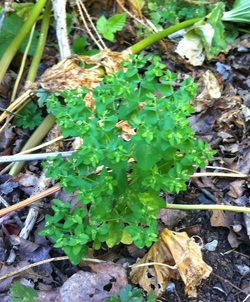 Petty Spurge is an introduced annual weed that is common at Leaning Oaks in cultivated areas, disturbed sites and gravelled paths. This plant (Euphorbia peplus) has a number of common names including Milkweed (which is terribly confusing since another genus entirely is also called Milkweed) and Cancer Weed. The name Cancer Weed is because the toxins in the milkly sap of this plant have an ingredient that has been shown to slow rapidly dividing cells down, and it has been used to treat cancerous lesions. The milky sap is also very bitter, and the plant doesn't seem to be consumed by either deer or rabbits here. Fortunately it is rather easily pulled or hoed out of the ground. This syrphid or hoverfly was introduced to North America prior to 1874 based on specimens. It has spread from Alaska to Florida and is common throughout the range. They are active pollinators, working over a wide range of plants. They are mimics of the European honey bee.
The aquatic larvae are called rat-tailed maggots. - The "tail" works like a siphon and will extend out of the fetid water that it is living in to breathe. They need to feed so there must be some food present. The eggs are laid in contaminated water, sewage or decomposing matter. The scientific name is Eristalis tenax. |
AuthorsTwo biologists on a beautiful property armed with cameras, smart phones and a marginal knowledge of websites took up the challenge of documenting one species a day on that property. Join along! Posts and photographs by Leah Ramsay and David Fraser (unless otherwise stated); started January 1, 2014. Categories
All
Archives
May 2025
|
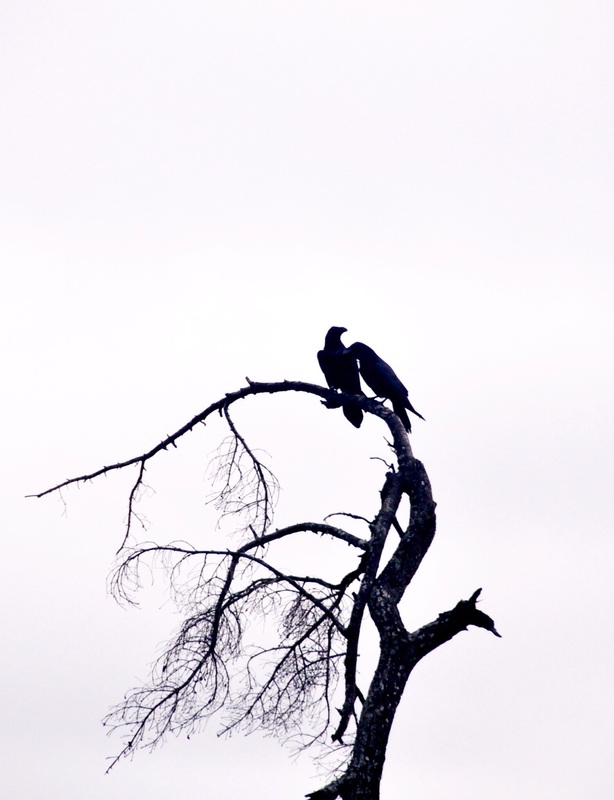
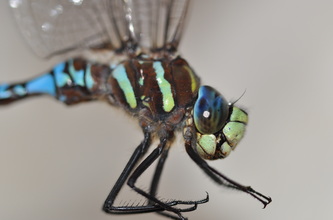
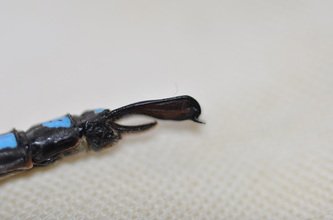
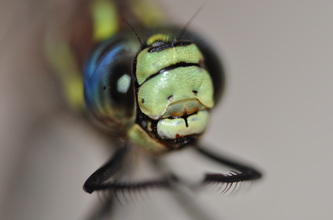
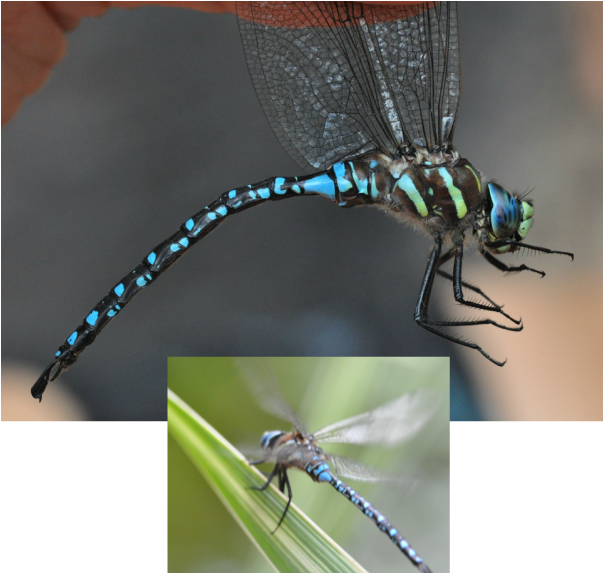
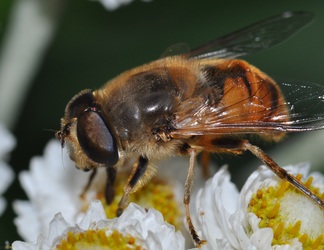
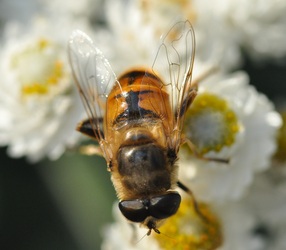
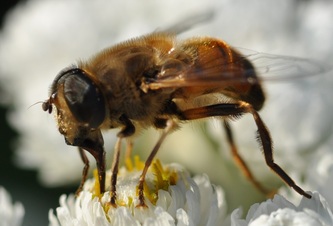
 RSS Feed
RSS Feed